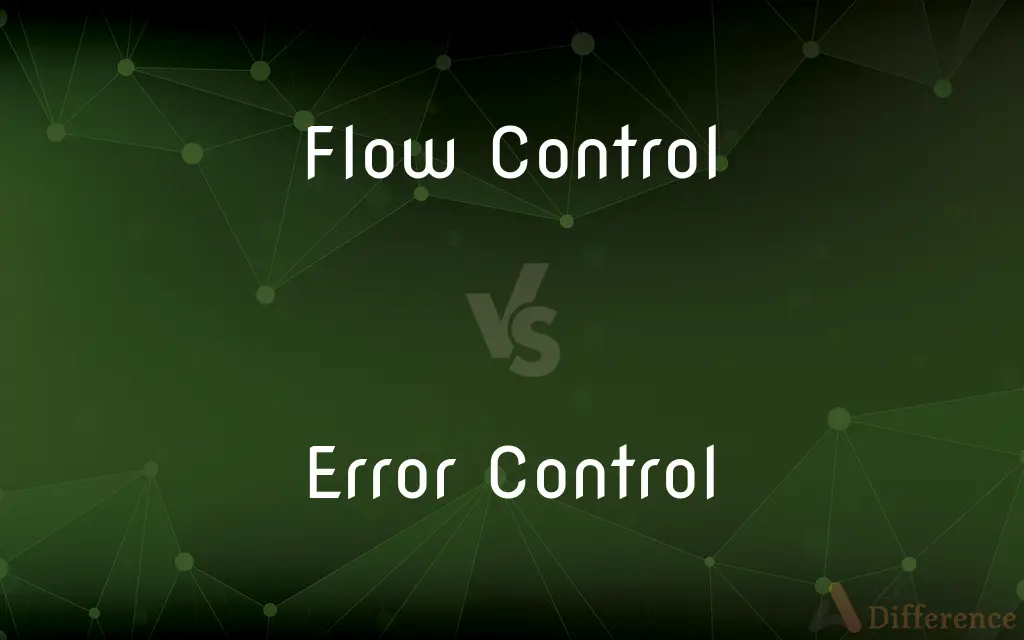Flow Control vs. Error Control — What's the Difference?
By Tayyaba Rehman & Fiza Rafique — Published on February 4, 2024
Flow Control ensures smooth data transmission between sender and receiver, avoiding overflow. Error Control detects and corrects errors in transmitted data.

Difference Between Flow Control and Error Control
Table of Contents
ADVERTISEMENT
Key Differences
Flow Control manages data transmission speed between two devices to prevent overwhelming the receiver. Error Control ensures data integrity by detecting and correcting transmission errors.
Flow Control uses techniques like buffering to maintain a balance in data transfer rate. Error Control employs methods like checksums to identify and rectify data errors.
Flow Control adjusts the data flow based on the receiver's capacity. Error Control focuses on maintaining data accuracy despite transmission disturbances.
Flow Control is essential for efficient data handling in networks. Error Control is crucial for reliable data communication over error-prone channels.
Flow Control and Error Control are complementary in achieving efficient and accurate data transmission in networking.
ADVERTISEMENT
Comparison Chart
Purpose
Manages data transfer rate
Detects and corrects data errors
Method
Uses buffering, windowing
Employs checksums, parity bits
Focus
Prevents receiver overload
Maintains data integrity
Role in Networking
Ensures efficient data handling
Guarantees data accuracy
Tools
Sliding window, pause frames
Automatic Repeat reQuest (ARQ), Forward Error Correction (FEC)
Compare with Definitions
Flow Control
Regulation of data transfer rate between devices.
To prevent buffer overflow, the router implemented flow control.
Error Control
System to handle errors in data transmission processes.
The new protocol includes advanced error control features for better accuracy.
Flow Control
Technique to control the pace of data transmission.
Flow control is essential in a high-traffic network environment.
Error Control
Technique to identify and fix errors in transmitted data.
Error control algorithms corrected the corrupted data packets.
Flow Control
A method to match sender's and receiver's data handling speeds.
Flow control is used to synchronize data transmission in a busy network.
Error Control
Method to maintain data integrity in digital communication.
Error control is vital for error-free data transmission in wireless networks.
Flow Control
Process of managing data buffering during transmission.
The server uses flow control to manage incoming data efficiently.
Error Control
Process to ensure accurate data delivery across networks.
The system's error control capabilities helped maintain reliable communication.
Flow Control
Method to avoid data congestion in communication systems.
Flow control mechanisms prevent data loss during peak usage times.
Error Control
Mechanism for detecting and correcting data transmission errors.
Error control was applied to ensure data integrity over the noisy channel.
Common Curiosities
Why is Flow Control important in networks?
Flow Control is important to ensure smooth data communication and prevent data loss or congestion in networks.
What is Error Control in networking?
Error Control is a technique in networking to detect and correct errors that occur during data transmission.
What is Flow Control?
Flow Control is a network management technique that regulates data transfer rates to prevent receiver overload.
Can Flow Control affect network performance?
Yes, proper Flow Control can enhance network performance by avoiding bottlenecks and ensuring efficient data handling.
How does Flow Control work?
Flow Control works by matching the speed at which data is sent with the receiver's ability to process it, using mechanisms like buffering.
How does Error Control ensure data integrity?
Error Control uses methods like checksums and parity bits to identify errors in data and then corrects them.
Can Error Control mechanisms slow down data transmission?
While they can add some processing overhead, Error Control mechanisms are crucial for reliable and accurate data transmission.
What are common Error Control techniques?
Common Error Control techniques include Automatic Repeat reQuest (ARQ) and Forward Error Correction (FEC).
Is Error Control necessary in all types of networks?
Yes, Error Control is essential in all networks, especially where there's a higher risk of data corruption or loss.
Can Error Control fix all types of transmission errors?
Error Control can fix many common errors, but not all; some errors might still require manual intervention or retransmission.
Can these mechanisms be customized according to network needs?
Yes, Flow Control and Error Control mechanisms can be adjusted or customized according to specific network requirements and conditions.
What happens if Flow Control fails in a network?
If Flow Control fails, it can lead to data congestion, packet loss, and reduced network performance.
Are Flow Control and Error Control interdependent?
While they serve different purposes, Flow Control and Error Control are complementary in ensuring efficient and reliable data communication.
Do modern networking protocols include both Flow Control and Error Control?
Yes, modern networking protocols typically incorporate both Flow Control and Error Control mechanisms.
How do Flow Control and Error Control contribute to network stability?
Together, they maintain a balance in data transmission rates and ensure data accuracy, contributing to overall network stability.
Share Your Discovery

Previous Comparison
HTML5 vs. XHTML5
Next Comparison
VB vs. VB.NETAuthor Spotlight
Written by
Tayyaba RehmanTayyaba Rehman is a distinguished writer, currently serving as a primary contributor to askdifference.com. As a researcher in semantics and etymology, Tayyaba's passion for the complexity of languages and their distinctions has found a perfect home on the platform. Tayyaba delves into the intricacies of language, distinguishing between commonly confused words and phrases, thereby providing clarity for readers worldwide.
Co-written by
Fiza RafiqueFiza Rafique is a skilled content writer at AskDifference.com, where she meticulously refines and enhances written pieces. Drawing from her vast editorial expertise, Fiza ensures clarity, accuracy, and precision in every article. Passionate about language, she continually seeks to elevate the quality of content for readers worldwide.













































